
It seems like every historical costumer’s journey to a closet full of pretty things to wear always includes a trip… or two… or three… to the local fabric store. We inevitably find ourselves on the quick run to grab thread, hook & eyes or even ribbon.
But for so many of us (and yes, I do include myself here) that local store is about all we have to choose from. Short of dishing out oodles of cash or credit to online vendors who hock their gorgeous wares, tempting us to give in to luscious silks and English laces, we “settle” for what we can get our hands on fast – literally.
So is it still worth taking the time to shop at these nationwide chain stores?
I think it is.
(All the project photos shown here were made primarily from chain store materials.)

Despite their shortcomings for historical costuming supplies, the Big Box stores like JoAnn Fabrics, Hancock Fabrics, Michael’s and Hobby Lobby do have their place in the larger scheme of sewing. For strategic shopping tips go here to get a bonus article.
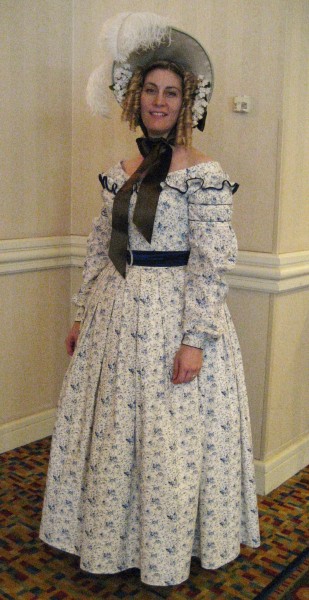
The desire to create period clothing shouldn’t be limited to the size of our wallets. So what if you have a budget of $500 for a new silk bustle dress. That’s awesome if you do! Then we will expect great things from your skills.
But if you’re like most of us who simply want to create historical fashion for the sake of expressing our personality and skills, to play dress up, and bring the beauty of the fashionable past into our lives, our $50 budget should not be a boulder in the road. If you only have so much to spend, you’ll definitely be looking at lower-cost materials.
This is where the chain stores come in.
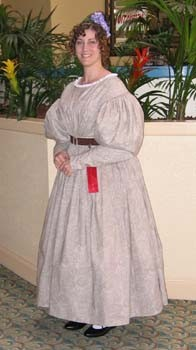
Even if you’re shopping in the cotton calico section, a well-chosen solid or print fabric can go quite far in pulling off a believable Regency or Victorian costume.
If you don’t have the money, you’ll need to spend the time researching print patterns of the era – before going to the store – ’cause I know, when you get into that vibrant calico aisle all those colors just call to you.
If you’re lacking in textile knowledge of say, the 1830s, you might fall in love with a print that’s just too modern. By selecting that one it will immediately set your project into the “costume-y” category – possibly not something you want.

So before you go make that JoAnn’s run or stop at Hobby Lobby on the way home, have in mind the time period you’re re-creating. This will help ENORMOUSLY in making your costume look like clothing.
But choosing a decent fabric isn’t all that goes into a credible costume. Sure, we all know the button and trim selections are greatly lacking at JoAnn’s and Hancock’s – meaning they scream modern craft projects.
But if you spend a little extra time shopping, treasures can be found that will work just fine on your 1880s day dress.
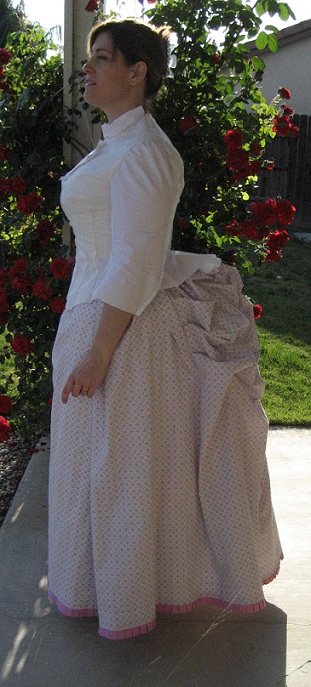
Avoid really plastic looking buttons. However, there are some great buttons made from plastic with the perfect Victorian painted or etched design. Some do a really good job at imitating glass too. Metal works well (as long as it isn’t too modern or whimsical) as does mother-of-pearl & shell buttons. You can definitely find those in chain stores.
And who says you can’t find good trims?
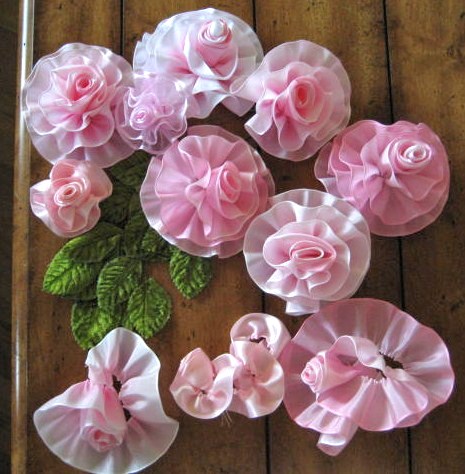
AT ALL COST avoid those cheap, large cardboard spools of 19 cent nasty nylon laces. They usually come pre-gathered and are just awful! I think more than anything, these cheapen the look of whatever you are making – dress, hat or blouse.
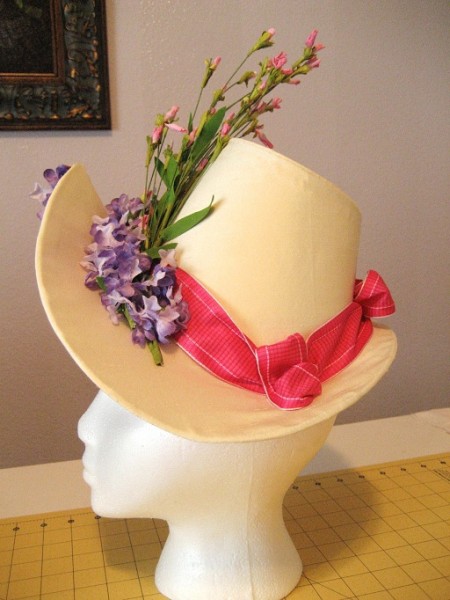
And the sad thing is, I see them used on EVERYTHING that some retailers sell as “Victorian.” UGH! No, no, no! Just because JoAnn’s and Michaels sell them doesn’t mean they are proper to use.
Please don’t use them.
Especially if you want to make a costume that is as close to historical as you can get it.
You want to hang out with the long, white oval spools for the nicer lace. Of course the higher price is usually the higher quality , but you’ll still have to look.
I’ve used many cotton and even cotton/poly or 100% poly trims that pull a period look quite well. (And the best thing with the cotton ones is that they dye well. Use tea or coffee for an “aged” look.)
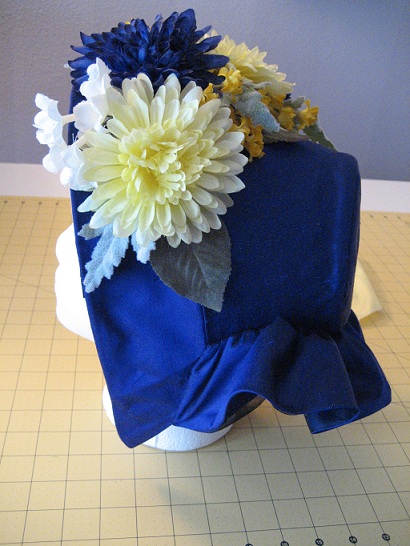
If you’re making pleated ribbon trims, look at the wired edge spools and simply remove the wires. I’ve found Michaels has a nice selection of ribbon I’ve used on lots of costumes.
I know sometimes the boring goods you see at the chain stores are, well… boring. They might also seem generic, like you’ll look like everyone else in your group. No such thing. Combine the elements of fit and good sewing techniques and even the cheap, run-0f-the-mill materials will turn into something worth showing off.

For many more resources for your historical costumes, visit my many Resources pages for vendors and sites.
Have you made any successful Regency, Romantic Era, Civil War or Victorian costumes with materials mainly from chain stores? How did they turn out? I’d love to hear about your experiences in the comments below!

I haven’t made a costume yet and I don’t know much about sewing but I learned alot about fabrics, etc, from reading you article “7 Strategies From Creating Realistic Historical Clothing From Chain Fabric Stores.” Thanks, very much. It has enlightened me very much on sewing and making costumes.
So glad you liked it Neil!
I know I’m late to the game here but just came across this article.
I just started costuming a few years ago. I am trying for a costume for each of the fashion periods. That being said, I go to garage sales to get old white sheets or tablecloths for cheap to use in place of muslin from the store. Sometimes you come across embroidered or crocheted sheets/tablecloths which is a plus!
At garage sales ALWAYS ask if they have any old notions they want to get rid of. They may say no but it never hurts to ask. One time got lucky and got a small vintage box of buttons and they only asked for $3.00. Woot! Another place I ended up with 32 sets of vintage, but usable, knitting needles, in a 1940s wooden container for $5. So… ASK!
Also, at thrift shops, many times you can find articles of clothing where the cloth/style is close to looking accurate and needs only a few tweaks to make it work. I found a 3x teal, full length, 100% cotton skirt that I will be able to use for my early 1870s Victorian bustle skirt. I will need to remove the elastic but, with the bustle and all the trim I’ll put on it, you won’t be able to tell it’s modern.
I made a ball gown out of dark blue changeable taffeta that I bought on a half price sale at Joann’s for a late civil war dress. Decided to copy a Godey’s book dress. 4 yards for the black velvet (yup Joann’s) bodice with a bertha neckline of alternating taffeta and black velvet. Then I guess I went crazy after that. 42 yards of pleating , ruching, hand beaded lace. I told everyone that it was my “mourning dress” because after all that work, I intend to be buried in it! That skirt has to have 15 yards of taffeta. Now I’m doing costumes for a tv show that takes place in 1885. That skirt bustles so amazingly when you pull that fabric around to the back!! I love to copy petersons, godey’s and Leslie offerings. I guess I am just as nutty as the next gal after all! I live in the wrong era. I need to move! 🙂
Great story!
Excellent suggestions Jennifer. I find it also helps to combine the new fabric with vintage/antique touches. New fabric with old lace picked up at a flea market for a few dollars and old buttons from your grandmother’s tin, really step up the period look and feel. I’m lucky to have an antiques flea market nearby and usually can find a bit of this or that once a month to put in my stash for very reasonable prices.
Another place for great fabrics for costumes is Calico fabrics. Not only do they often have great sales, but their fabrics are upholstery wide, have great and interesting patterns, and the variety of weight and textures and colors is enought to get those creative juices flowing. I also like to browse in antique or consignment shops. I look for old textiles and laces and old embroidered table cloths and napkins. Those old, stained, magnificently embroidered cloths clean up nicely and are often made of fabrics no longer available in today’s general market. I have made first communion dresses and christening gowns out of these.
I’m ridiculously lucky that I live in an English city that has a strong textiles heritage and a big Asian population,, and a partner who works in textiles, most of my outfits are made on a 50 quid budget, but I did get really lucky to find a roll of cloth that worked from the late 18th century right into the Victorian era for a pound a yard, I ended up buying all 32 yards and so far I’ve gotten a 1780 dress out of it and a 1795 dress out of it.
What a great deal!
I have made a few regency garments using joanns supplies (usually in tandem with the LA garment district). I did just what you said:researched what colors and prints would be appropriate for the period. I ended up finding something perfect! Just the right colors and scale of print. 🙂
Basically everything I’ve made has been from chain stores. I have a few thrift store treasures that I’ve managed to cobble outfits together, but by and large it’s Jo Annes, Hancocks and Pacific Fabrics.
My first Victorian/Civil War Era costume is a tea gown made from materials purchased primarily from Hancock Fabrics. I receive compliments on it, and the matching spoon bonnet that I also made, every time I wear them.